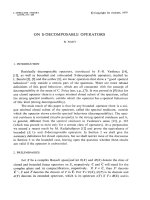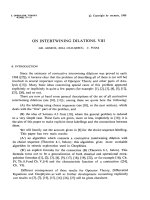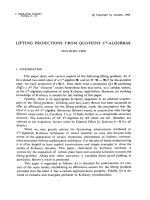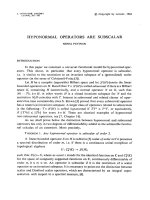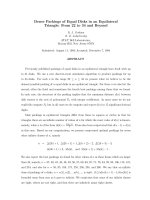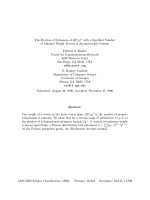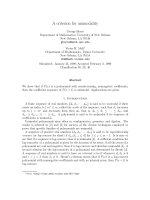Báo cáo toán học: " 3-Designs from PGL(2, q)" docx
Bạn đang xem bản rút gọn của tài liệu. Xem và tải ngay bản đầy đủ của tài liệu tại đây (117.69 KB, 11 trang )
3-Designs from PGL(2,q)
P. J. Cameron
c
G. R.Omidi
a,b
B. Tayfeh-Rezaie
a
a
Institute for Studies in Theoretical Physics and Mathematics (IPM),
P.O. Box 19395-5746, Tehran, Iran
b
School of Mathematics, Statistics and Computer Science,
University of Tehran, Tehran, Iran
c
School of Mathematical Sciences, Queen Mary, University of London, U.K.
E-mails: , ,
Submitted: Sep 28, 2005; Accepted: May 9, 2006; Published: May 19, 2006
Mathematics Subject Classifications: 05B05, 20B20
Abstract
The group PGL(2,q), q = p
n
, p an odd prime, is 3-transitive on the projective
line and therefore it can be used to construct 3-designs. In this paper, we determine
the sizes of orbits from the action of PGL(2,q)onthek-subsets of the projective line
when k is not congruent to 0 and 1 modulo p. Consequently, we find all values of
λ for which there exist 3-(q +1,k,λ) designs admitting PGL(2,q) as automorphism
group. In the case p ≡ 3 (mod 4), the results and some previously known facts are
used to classify 3-designs from PSL(2,p) up to isomorphism.
Keywords: t-designs, automorphism groups, projective linear groups, M¨obius functions
1 Introduction
Let q = p
n
,wherep is an odd prime and n is a positive integer. The group PGL(2,q)
is 3-transitive on the projective line and therefore, a set of k-subsets of the projective
line is the block set of a 3-(q +1,k,λ) design admitting PGL(2,q) as an automorphism
group for some λ if and only if it is a union of orbits of PGL(2,q). There are some known
results on 3-designs from PGL(2,q) in the literature, see for example [1, 4, 6]. In this
paper, we first determine the sizes of orbits from the actions of subgroups of PGL(2,q)on
the projective line. Then we use the M¨obius inversion to find the sizes of orbits from the
action of PGL(2,q)onthek-subsets of the projective line when k is not congruent to 0
and 1 modulo p. Consequently, all values of λ for which there exist 3-(q +1,k,λ)designs
admitting PGL(2,q) as automorphism group are identified. We also use the results and
some previously known facts to classify 3-designs from PSL(2,p) up to isomorphism when
p ≡ 3 (mod 4). We note that similar methods have been used in [7].
the electronic journal of combinatorics 13 (2006), #R50 1
2 Notation and Preliminaries
Let t, k, v and λ be integers such that 0 ≤ t ≤ k ≤ v and λ>0. Let X be a v-set and
P
k
(X)denotethesetofallk-subsets of X.At-(v,k, λ) design is a pair D =(X, D)in
which D is a collection of elements of P
k
(X) (called blocks) such that every t-subset of X
appears in exactly λ blocks. If D has no repeated blocks, then it is called simple. Here,
we are concerned only with simple designs. If D = P
k
(X), then D is said to be the trivial
design. An automorphism of D is a permutation σ on X such that σ(B) ∈ D for each
B ∈ D.Anautomorphism group of D is a group whose elements are automorphisms of
D.
Let G be a finite group acting on X.Forx ∈ X,theorbit of x is G(x)={gx| g ∈ G}
and the stabilizer of x is G
x
= {g ∈ G| gx = x}.Itiswellknownthat|G| = |G(x)||G
x
|.
The orbits of size |G| are called regular and the others non-regular.Ifthereisanx ∈ X
such that G(x)=X,thenG is called transitive. The action of G on X induces a natural
action on P
k
(X). If this latter action is transitive, then G is said to be k-homogeneous.
Let q be a prime power and let X = GF (q) ∪{∞}. Then, the set of all mappings
g : x →
ax + b
cx + d
,
on X such that a, b, c, d ∈ GF (q), ad − bc is nonzero and g(∞)=a/c, g(−d/c)=∞
if c =0,andg(∞)=∞ if c = 0, is a group under composition of mappings called the
projective general linear group and is denoted by PGL(2,q). If we consider the mappings g
with ad−bc a nonzero square, then we find another group called the projective special linear
group which is denoted by PSL(2,q). It is well known that PGL(2,q) is 3-homogeneous
(in fact it is 3-transitive) and | PGL(2,q)| =(q
3
− q). Hereafter, we let p be a prime,
q = p
n
and q ≡ (mod 4),where = ±1. Since PGL(2,q) is 3-homogeneous, a set of
k-subsets of X is a 3-(q +1,k,λ) design admitting PGL(2,q) as an automorphism group
if and only if it is a union of orbits of PGL(2,q)onP
k
(X). Thus, for constructing designs
with block size k admitting PGL(2,q), we need to determine the sizes of orbits from the
action of PGL(2,q)onP
k
(X).
Let H ≤ PGL(2,q) and define
f
k
(H):=thenumberofk-subsets fixed by H,
g
k
(H):=thenumberofk-subsets with the stabilizer group H.
Then we have
f
k
(H)=
H≤U≤PGL(2,q)
g
k
(U). (1)
The values of g
k
can be used to find the sizes of orbits from the action of PGL(2,q)on
P
k
(X). So we are interested in finding g
k
. But it is easier to find f
k
and then to use it to
compute g
k
.BytheM¨obius inversion applied to (1), we have
g
k
(H)=
H≤U≤PGL(2,q)
f
k
(U)µ(H, U), (2)
the electronic journal of combinatorics 13 (2006), #R50 2
where µ is the M¨obius function of the subgroup lattice of PGL(2,q).
For any subgroup H of PGL(2,q), we need to carry out the following:
(i) Find the sizes of orbits from the action of H on the projective line and then compute
f
k
(H).
(ii) Calculate µ(H, U) for any overgroup U of H and then compute g
k
(H) using (2).
Note that if H and H
are conjugate, then f
k
(H)=f
k
(H
)andg
k
(H)=g
k
(H
). There-
fore, we need to apply the above steps only to the representatives of conjugacy classes of
subgroups of PGL(2,q).
In the next section, we will review the structure of subgroups of PGL(2,q)andtheir
overgroups. Then, Step (i) of the above procedure will be carried out in Section 4 for
any subgroup of PGL(2,q). For Step (ii), we will make use the values of M¨obius function
of the subgroup lattice of PSL(2,q) given in [2]. The results will be used to find new
3-designs with automorphism group PGL(2,q)inSection7.
3 The subgroups of PGL(2,q)
The subgroups of PSL(2,q) are well known and are given in [3, 5]. These may also be
found in [2] together with some results on the overgroups of subgroups. Since PGL(2,q)is
a subgroup of PSL(2,q
2
) and it has a unique subgroup PSL(2,q), we can easily extract all
necessary information concerning the subgroups of PGL(2,q) and their overgroups from
the results of [2].
Theorem 1 Let g be a nontrivial element in PGL(2,q) of order d and with f fixed points.
Then d = p, f =1or d|q ± , f =1∓ .
Theorem 2 The subgroups of PGL(2,q) are as follows.
(i) Two conjugacy classes of cyclic subgroups C
2
. One (class 1) consisting of q(q + )/2
of them which lie in the subgroup PSL(2,q), the other one (class 2) consisting of
q(q − )/2 subgroups C
2
.
(ii) One conjugacy class of q(q ∓ )/2 cyclic subgroups C
d
, where d|q ± and d>2.
(iii) Two conjugacy classes of dihedral subgroups D
4
. One (class 1) consisting of q(q
2
−
1)/24 of them which lie in the subgroup PSL(2,q), the other one (class 2) consisting
of q(q
2
− 1)/8 subgroups D
4
.
(iv) Two conjugacy classes of dihedral subgroups D
2d
, where d|
q±
2
and d>2. One (class
1) consisting of q(q
2
−1)/(4d) of them which lie in the subgroup PSL(2,q), the other
one (class 2) consisting of q(q
2
− 1)/(4d) subgroups D
2d
.
(v) One conjugacy class of q(q
2
− 1)/(2d) dihedral subgroups D
2d
, where (q ± )/d is an
odd integer and d>2.
the electronic journal of combinatorics 13 (2006), #R50 3
(vi) q(q
2
− 1)/24 subgroups A
4
, q(q
2
− 1)/24 subgroups S
4
and q(q
2
− 1)/60 subgroups A
5
when q ≡±1 (mod 10). There is only one conjugacy class of any of these types of
subgroups and all lie in the subgroup PSL(2,q) except for S
4
when q ≡±3(mod8).
(vii) One conjugacy class of p
n
(p
2n
− 1)/(p
m
(p
2m
− 1)) subgroups PSL(2,p
m
), where m|n.
(viii) The subgroups PGL(2,p
m
), where m|n.
(ix) The elementary Abelian group of order p
m
for m ≤ n.
(x) A semidirect product of the elementary Abelian group of order p
m
, where m ≤ n and
the cyclic group of order d, where d|q − 1 and d|p
m
− 1.
Here, we are specially interested in the subgroups (i)-(vi) in Theorem 2. For any
subgroup of types (i)-(vi), we may find the number of overgroups which are of these types
using Theorem 2 and the next two lemmas.
Lemma 1 C
d
has a unique subgroup C
l
for any l>1 and l|d. The nontrivial subgroups
of the dihedral group D
2d
are as follows: d/l subgroups D
2l
for any l|d and l>1, a unique
subgroup C
l
for any l|d and l>2, d subgroups C
2
if d is odd and d +1 subgroups C
2
otherwise. Moreover D
2d
has a normal subgroup C
2
if and only if d is even.
Lemma 2 The conjugacy classes of nontrivial subgroups of A
4
,S
4
and A
5
are as follows.
group C
2
C
2
C
3
C
4
C
5
D
4
D
4
D
6
D
8
D
10
A
4
A
4
34 1
S
4
3643 1343 1
A
5
15 10 6 5 10 6 5
Lemma 3 The numbers of proper cyclic and dihedral overgroups of C
2
and D
4
are given
in the following table, where c1 and c2 refer to classes 1 and 2, respectively.
overgroups C
2
(c1) C
2
(c2) D
4
(c1) D
4
(c2)
C
2f
(f|
q+
2
,f >1) 0 1 −−
C
2f
(f|
q−
2
,f >1) 1 0 −−
D
4
(c1)
q−
4
0 −−
D
4
(c2)
q−
4
q+
2
−−
D
2f
(f|
q±
2
, f even, f > 2) (c1)
(q−)(f+1)
2f
030
D
2f
(f|
q±
2
, f even, f > 2) (c2)
q−
2f
q+
2
01
D
2f
(f|
q±
2
, f odd, f > 2) (c1)
q−
2
000
D
2f
(f|
q±
2
, f odd, f > 2) (c2)0
q+
2
00
D
2f
(f |
q±
2
,f|q ± , 4|f)
(q−)(f+2)
2f
q+
2
31
D
2f
(f |
q±
2
,f|q ± , 4 |f, f > 2)
q−
2
(q+)(f+2)
2f
02
the electronic journal of combinatorics 13 (2006), #R50 4
Lemma 4 Let ld|q ± and d>2.
(i) Any C
d
is contained in a unique subgroup C
ld
.
(ii) Any C
d
is contained in (q ± )/(ld) subgroups D
2ld
(if this latter group has more
than one conjugacy classes, then C
d
is contained in the same number of groups for
each of classes).
(iii) Any D
2d
is contained in a unique subgroup D
2ld
(if this latter group has more than
one conjugacy classes, then its class number must be same as D
2d
).
Lemma 5
(i) Any C
2
of class 1 is contained in (q − )/2 subgroups S
4
as a subgroup with 6
conjugates (see Lemma 2) when q ≡±1(mod8).
(ii) Any C
2
of class 2 is contained in (q + )/2 subgroups S
4
as a subgroup with 6
conjugates (see Lemma 2) when q ≡±3(mod8).
(iii) Any C
2
of class 1 is contained in (q − )/2 subgroups A
5
when q ≡±1 (mod 10).
(iv) Let 3|q ± . Then any C
3
is contained in (q ± )/3 subgroups A
4
, (q ±)/3 subgroups
S
4
and (q ± )/3 subgroups A
5
when q ≡±1 (mod 10).
(v) Any A
4
is contained in a unique S
4
and 2 subgroups A
5
when q ≡±1 (mod 10).
Lemma 6
(i) Any D
4
of class 1 is contained in a unique A
4
and it is in a unique S
4
in which it
is normal.
(ii) Any D
6
of class 1 is contained in 2 subgroups S
4
when q ≡±1(mod8)and 2
subgroups A
5
when q ≡±1 (mod 10).
(iii) Any D
6
of class 2 is contained in 2 subgroups S
4
when q ≡±3(mod8).
(iv) Any D
8
of class 1 is contained in 2 subgroups S
4
when q ≡±1(mod8).
(v) Any D
8
is contained in one subgroup S
4
when q ≡±3(mod8).
(vi) Any D
10
of class 1 is contained in 2 subgroups A
5
when q ≡±1 (mod 10).
the electronic journal of combinatorics 13 (2006), #R50 5
4 The action of subgroups on the projective line
In this section we determine the sizes of orbits from the action of subgroups of PGL(2,q)
on the projective line. Here, the main tool is the following observation: If H ≤ K ≤
PGL(2,q), then any orbit of K is a union of orbits of H. In the following lemmas we
suppose that H is a subgroup of PGL(2,q)andN
l
denotes the number of orbits of size l.
We only give non-regular orbits.
Lemma 7 Let H be the cyclic group of order d, where d|q ± .
(i) Let d =2. Then for H in class 1, we have N
1
=1+ and for H in class 2,
N
1
=1− .
(ii) Let d>2. Then N
1
=1∓ .
Proof. This is trivial by Theorem 1.
Lemma 8 Let H be the dihedral group of order 2d, where d|q ± .
(i) Let d =2. Then for H in class 1, we have N
2
=3(1+)/2 and for H in class 2,
N
2
=(3− )/2.
(ii) Let d>2. Then N
2
=(1∓ )/2 and
d|
q+
2
, (c1) d|
q+
2
, (c2) d|
q−
2
, (c1) d|
q−
2
, (c2) d |
q+
2
d |
q−
2
N
d
1+ 1 − 1+ 1 − 11
where c1 and c2 denote classes 1 and 2, respectively.
Proof. (i) We know that H does not stabilize any point. So the orbits are of sizes 2
or 4. Now the assertion follows from solving the equations N
2
+ N
4
=
1
4
g∈H
fix(g)and
2N
2
+4N
4
= q +1.
(ii) By Lemma 7, the orbits are of sizes 2, d or 2d. The orbits of size 2 have the unique
subgroup C
d
of D
2d
as their stabilizers. So by Lemma 7, we have N
2
=(1∓ )/2. Now
N
d
and N
2d
are easily found in the same way to (i).
Lemma 9 Let H be the group A
4
. Then N
6
=(1+)/2 and
(i) if 3|q ± , then N
4
=1∓ ,
(ii) if 3|q, then N
4
=1.
Proof. H has D
4
as a subgroup and therefore by Lemma 8, the orbit sizes are even.
Since A
4
has no subgroup of order 6, there is no orbit of size 2. Hence, the possible orbit
sizes are 4, 6 or 12. A
4
has 3 subgroups C
2
each fixing 1 + points and therefore, we have
N
6
=(1+)/2.
(i) H has a subgroup of order 3 fixing 1 ∓ points and therefore, N
4
=1∓ .
(ii) H has a subgroup of order 3 with one fixed point. Hence, N
4
=1.
the electronic journal of combinatorics 13 (2006), #R50 6
Lemma 10 Let H be the group S
4
. Then N
6
=(1+)/2 and
(i) if 3|q + and 8|q − , then N
8
=
1−
2
and N
12
=
1+
2
,
(ii) if 3|q + and 8|q +3, then N
8
=
1−
2
and N
12
=
1−
2
,
(iii) if 3|q − and 8|q − , then N
8
=
1+
2
and N
12
=
1+
2
,
(iv) if 3|q − and 8|q +3, then N
8
=
1+
2
and N
12
=
1−
2
,
(v) if 3|q, then N
4
=1.
Proof. By Lemma 9, the orbits are of sizes 4, 6, 8, 12 or 24. The orbits of size 6 have
C
4
as their stabilizer and S
4
has three subgroups C
4
. So by Lemma 7 and noting that
4|q − and 4 |q + , we obtain that N
6
=(1+)/2.
(i)–(iv) Let 3|q ± .SinceD
6
does not stabilize any point, there is no orbit of size
4. Now Lemma 9(i) implies N
8
=
1∓
2
.If8|q − ,thenH has a subgroup D
8
which by
Lemma 8, apart from the regular orbits it has (1 + )/2 orbits of size 2 and 1 + orbits
of size 4. So in this case, N
12
=(1+)/2. If 8|q +3,thenH has a subgroup D
8
which
byLemma8has(1+)/2 orbits of size 2 and one orbit of size 4. Hence, N
12
=(1− )/2.
(v) By Lemma 9(ii), N
4
= 1. We show that N
12
=0. If8|q − ,then =1andH has
a subgroup D
8
which by Lemma 8, apart from the regular orbits it has two orbits of size
4. So in this case N
12
=0. If8|q +3,then = −1andH has a subgroup D
8
which apart
from the regular orbits it has one orbit of size 4 by Lemma 8. Hence, we have N
12
=0.
Lemma 11 Let 5|q ± and H be the group A
5
. Then N
12
=(1∓ )/2 and
(i) if 3|q ± , then N
20
=(1∓ )/2 and N
30
=(1+)/2,
(ii) if 3|q, then N
10
=1.
Proof. H has 6 subgroups C
5
which are the stabilizer groups of their own fixed points.
Therefore, by Lemma 7, N
12
=(1∓ )/2.
(i) By Lemma 9, a subgroup A
4
of H has (1 ∓ )/2orbitsofsize4,(1+)/2orbitsof
size 6 and all other orbits are regular. So clearly the assertion holds.
(ii) We have = 1. By Lemma 9, a subgroup A
4
of H has one orbit of size 4, one
orbit of size 6 and all other orbits are regular. Therefore, the assertion is obvious.
Lemma 12 Let H be the elementary Abelian group of order p
m
, where m ≤ n. Then
N
1
=1.
Proof. By the Cauchy-Frobenius lemma, the number of orbits is p
n−m
+1. Notethat
all orbit sizes are powers of p. Therefore, we just have one orbit of size one and all other
orbits are regular.
Lemma 13 Let H be a semidirect product of the elementary Abelian group of order p
m
,
where m ≤ n and the cyclic group of order d, where d|q − 1 and d| p
m
− 1. Then N
1
=1
and N
p
m
=1.
the electronic journal of combinatorics 13 (2006), #R50 7
Proof. H has an elementary Abelian subgroup of order p
m
. So by Lemma 12, we have
one orbit of size 1 and all other orbit sizes are multiples of p
m
. On the other hand, H has
a cyclic subgroup of order d and therefore by Lemma 7, the orbit sizes are congruent 0 or
1 modulo d. If congruent 0 modulo d, then orbit size is necessarily dp
m
. Otherwise, orbit
size must be 1 or p
m
. Now the assertion follows from the fact that an element of order d
has two fixed points.
Lemma 14 Let H be PSL(2,p
m
) or PGL(2,p
m
), where m|n. Then
(i) if p
m
+1|p
n
− 1, then =1and we have N
p
m
+1
=1and N
p
m
(p
m
−1)
=1,
(ii) if p
m
+1|p
n
+1, then N
p
m
+1
=1.
Proof. First let H be PSL(2,p
m
). All subgroups PSL(2,p
m
)ofPGL(2,q)arecon-
jugate by Theorem 2. So we may suppose that H is the group with the elements
x →
ax+b
cx+d
,a,b,c,d∈ GF (p
m
), where GF(p
m
) is the unique subfield of order p
m
of GF (p
n
).
Since H is transitive on GF(p
m
)∪{∞},wehaveoneorbitofsizep
m
+1. H has a subgroup
of order p
m
(p
m
− 1)/2 which is a semidirect product of the elementary Abelian group of
order p
m
and the cyclic group of order (p
m
− 1)/2. So by Lemma 13, all other orbits of
H are of multiples of p
m
(p
m
− 1)/2.
(i)Itiseasytoseethat =1. H has a subgroup D
p
m
+1
. By Lemma 8, we have one
orbit of size l(p
m
+1)/2 + 2 which is divisible by p
m
(p
m
− 1)/2. Now we immediately find
out that this orbit is of size p
m
(p
m
− 1). The remaining orbits are of sizes p
m
(p
m
− 1)/4
or p
m
(p
m
− 1)/2. Since C
2
is not the stabilizer of any point, we conclude that there is no
orbit of size p
m
(p
m
− 1)/4.
(ii) H has a fixed point free element of order (p
m
+1)/2 which forces orbits to be of
sizes of multiples of (p
m
+1)/2. Hence all orbits are of sizes p
m
(p
m
−1)/4orp
m
(p
m
−1)/2.
Since C
2
is not the stabilizer of any point, there is no orbit of size p
m
(p
m
− 1)/4.
Now let H be PGL(2,p
m
). Since H has a subgroup PSL(2,p
m
)andC
2
is not the
stabilizer of any point, the assertion follows immediately from the paragraphs above.
5TheM¨obius functions
In [2], we have made some calculations on the M¨obius functions of the subgroup lattices of
subgroups of PSL(2,q). We make use of the results of [2] and it turns out those are enough
for our purposes and we will need no more calculations. For later use, we summarize the
results in the following theorem.
Theorem 3 [2]
(i) µ(1,C
d
)=µ(d) and µ(C
l
,C
d
)=µ(d/l) if l|d.
(ii) µ(1,D
2d
)=−dµ(d), µ(D
2l
,D
2d
)=µ(d/l), µ(C
l
,D
2d
)=−(d/l)µ(d/l) if l|d and
l>2, µ(C
2
,D
2d
)=−(d/2)µ(d/2) if C
2
is normal in D
2d
and µ(C
2
,D
2d
)=µ(d)
otherwise.
the electronic journal of combinatorics 13 (2006), #R50 8
(iii) µ(1,A
4
)=4, µ(C
2
,A
4
)=0, µ(C
3
,A
4
)=−1 and µ(D
4
,A
4
)=−1.
(iv) µ(A
4
,S
4
)=−1, µ(D
8
,S
4
)=−1, µ(D
6
,S
4
)=−1, µ(C
4
,S
4
)=0, µ(D
4
,S
4
)=
3 for normal subgroup D
4
of S
4
and µ(D
4
,S
4
)=0otherwise, µ(C
3
,S
4
)=1,
µ(C
2
,S
4
)=0if C
2
isasubgroupwith3 conjugates (see Lemma 2) and µ(C
2
,S
4
)=2
otherwise, and µ(1,S
4
)=−12.
(v) µ(A
4
,A
5
)=−1, µ(D
10
,A
5
)=−1, µ(D
6
,A
5
)=−1, µ(C
5
,A
5
)=0, µ(D
4
,A
5
)=
0, µ(C
3
,A
5
)=2, µ(C
2
,A
5
)=4and µ(1,A
5
)=−60.
6 Determinations of f
k
and g
k
In Section 4, we determined the sizes of orbits from the action of subgroups of PGL(2,q)
on the projective line. The results are used to calculate f
k
(H) for any subgroup H and
1 ≤ k ≤ q + 1. Suppose that H has r
i
orbits of size l
i
(1 ≤ i ≤ s). Then by the definition,
we have
f
k
(H)=
s
i=1
m
i
l
i
=k
s
i=1
r
i
m
i
.
The results of Section 4 show that any nontrivial subgroup H of PGL(2,q) has at most
three non-regular orbits and so it is an easy task to compute f
k
. Here, we do not give the
values of f
k
for the sake of briefness. As an example, the reader is referred to [2], where
a table of values of f
k
for the subgroups of PSL(2,q)isgiven.
The values of f
k
are used to compute g
k
.Let1≤ k ≤ q +1andk ≡ 0, 1(modp).
The latter condition imposes f
k
(H)andg
k
(H) to be zero for any subgroup H belonging
to one of the classes (vii)-(x) in Theorem 2. Let H be a subgroup lying in one of the
classes (i)-(vi). By
g
k
(H)=
H≤U≤PGL(2,q)
f
k
(U)µ(H, U),
we only need to care about those overgroups U of H for which f
k
(U)andµ(H, U)are
nonzero. All we need on overgroups are provided by Theorem 2 and Lemmas 4–6. We
also know the values of the M¨obius functions and f
k
. So we are now able to compute g
k
.
We will not give the explicit formulas for g
k
, since we think it is only the simple problem
of substituting the appropriate values in the above formula.
7 Orbit sizes and 3-designs from PGL(2,q)
We use the results of the previous sections to show the existence of a large number of new
3-designs. First we state the following simple fact.
Lemma 15 Let H be a subgroup of PGL(2,q) and let u(H) denote the number of subgroups
of PGL(2,q) conjugate to H. ThenthenumberoforbitsofPGL(2,q) on the k-subsets
whose elements have stabilizers conjugate to H is equal to u(H)g
k
(H)|H|/| PGL(2,q)|.
the electronic journal of combinatorics 13 (2006), #R50 9
Proof. The number of k-subsets whose stabilizers are conjugate to H is u(H)g
k
(H)and
such k-subsets lie in the orbits of size | PGL(2,q)|/|H|.
The lemma above and Theorem 2 help us to compute the sizes of orbits from the
action of PGL(2,q)onthek-subsets of the projective line. Once the sizes of orbits are
known, one may utilize them to find all values of λ for which there exist 3-(q +1,k,λ)
designs admitting PGL(2,q) as automorphism group.
Theorem 4 Let 1 ≤ k ≤ q +1and k ≡ 0, 1(modp). Then the numbers of orbits of
G =PGL(2,q) on the k-subsets of the projective line are as follows (where d | q ± and
d>2) (c1 and c2 refer to classes 1 and 2, respectively).
stabilizer id A
4
S
4
A
5
C
2
(c1) C
2
(c2) C
d
number of orbits
g
k
(1)
q
3
−q
g
k
(A
4
)
2
g
k
(S
4
) g
k
(A
5
)
g
k
(C
2
)
q−
g
k
(C
2
)
q+
dg
k
(C
d
)
2(q±)
stabilizer D
4
(c1) D
4
(c2) D
2d
(c1,c2,d|
q±
2
) D
2d
(d |
q±
2
)
number of orbits
g
k
(D
4
)
6
g
k
(D
4
)
2
g
k
(D
2d
)
2
g
k
(D
2d
)
8 Non-isomorphic designs from PSL(2,p) and PGL(2,p)
It is known that PGL(2,p) is maximal in S
p+1
for p>23 [8]. Let p ≡ 3(mod4)and
p>23. Let X be the projective line and let H and K be some fixed subgroups PSL(2,p)
and PGL(2,p) of the symmetric group on X, respectively such that H<K.Foragiven
λ,letS and G be the sets of all nontrivial 3-(p +1,k,λ)designsonX admitting H and
K as automorphism group, respectively. Clearly, G⊆S. Since PGL(2,p) is not normal
in S
p+1
,alldesignsinG are mutually non-isomorphic. Moreover, these designs admit
PGL(2,p) as their full automorphism group. Since PSL(2,p) is maximal in PGL(2,p),
all designs in F = S\Gadmit PSL(2,p) as their full automorphism group. It is easy to
show that any design in F has exactly one isomorphic copy in F. In fact, the normalizer
of PSL(2,p)inS
p+1
is PGL(2,p). So g(D)=D
for distinct designs D and D
in F if and
only if g ∈ PGL(2,p) \ PSL(2,p).
the electronic journal of combinatorics 13 (2006), #R50 10
References
[1] T. Beth, D. Jungnickel and H. Lenz, Design theory, Second edition, Cambridge Uni-
versity Press, Cambridge, 1999.
[2] P. J. Cameron, H. R. Maimani, G. R. Omidi and B. Tayfeh-Rezaie, 3-Designs from
PSL(2,q), Discrete Math.,toappear.
[3] L. E. Dickson, Linear groups with an exposition of the Galois field theory,Dover
Publications, Inc., New York, 1958.
[4] D.R.Hughes,Ont-designs and groups, Amer. J. Math. 87 (1965), 761–778.
[5] B. Huppert, Endliche gruppen I, Die Grundlehren der Mathematischen Wis-
senschaften, Band 134, Springer-Verlag, Berlin–New York, 1967.
[6] S. Iwasaki and T. Meixner, A remark on the action of PGL(2,q) and PSL(2,q)on
the projective line, Hokkaido Math. J. 26 (1997), 203–209.
[7] R. Laue, S. S. Magliveras and A. Wassermann, New large sets of t-designs, J. Combin.
Des. 9 (2001), 40–59.
[8] M. W. Liebeck, Cheryl E. Praeger and J. Saxl, A classification of the maximal sub-
groups of the finite alternating and symmetric groups, J. Algebra 111 (1987), 365–
383.
the electronic journal of combinatorics 13 (2006), #R50 11

